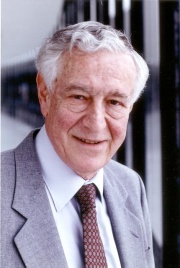-
(b.) -1927 February 04(d.)1999 April 28
Bio/Description
A German-American physicist he made important contributions in diverse areas of the thermodynamics of information processing, condensed matter physics, and the conductivity of disordered media. He was appointed IBM Fellow in 1969, the highest honor a scientist, engineer, or programmer at IBM can achieve. He was also a Life Fellow of the IEEE. He was born in Stuttgart, Germany and emigrated to the United States in 1938 to escape Nazi persecution of Jews at the age of 11. He graduated in 1943 from Stuyvesant High School, one of New York City's mathematics and science magnet schools, and obtained his undergraduate degree from Harvard in 1945. Following service in the US Navy as an Electrician's Mate, he earned his Ph.D. from Harvard in 1950. He worked for two years at NASA; then known as the National Advisory Committee for Aeronautics, and at the age of 25, he began a career in semiconductors at IBM. As part of the two-man team responsible for managing IBM's Research Division in the mid-1960s, he played a key role in the creation of a number of programs, including the company's work on semiconductor lasers. In 1961 he discovered Landauer's principle; that in any logically irreversible operation that manipulates information, such as erasing a bit of memory, entropy increases and an associated amount of energy is dissipated as heat. This principle is relevant to reversible computing, quantum information and quantum computing. He also was responsible for the Landauer formula relating the electrical resistance of a conductor to its scattering properties. Much of his research after 1969 related to the kinetics of small structures. He showed that in systems with two or more competing states of local stability, their likelihood depends on noise all along the path connecting them. In electron transport theory, he is particularly associated with the idea, taken from circuit theory, that electric flow can be considered a consequence of current sources as well as applied fields. He was also a pioneer in the area of information handling. His principles have been applied to computers and to the measurement process and are the basis for his own demonstration that communication, in principle, cannot avoid a small use of energy. He was the recipient of numerous awards; the Stuart Ballantine Medal of the Franklin Institute in1992; the Oliver Buckley Prize of the American Physical Society in 1995; the 1998 IEEE Edison Medal, ?For pioneering contributions to the physics of computing and conduction?; the Centennial Medal by Harvard in 1993; the Moet Hennessey Louis Vuitton (LVMH) Science for Art Prize in 1997; and the Rolf Landauer Medal of the International ETOPIM Association in 2009. He was a member of the National Academy of Engineering; a member of the National Academy of Sciences; and a member of the European Academy of Sciences and Arts. He was also named Fellow, American Academy of Arts and Sciences. He received an honorary doctorate from Technion in Israel and was the 1991 Scott Lecturer at the Cavendish Laboratory at Cambridge University. The range of his work has been recognized in special issues of two journals, 10 years apart: the IBM Journal of Research and Development (January 1988) and Superlattices and Microstructures (March/April 1998).
-
Date of Birth:
1927 February 04 -
Date of Death:
1999 April 28 -
Noted For:
Significant contributor in diverse areas of the thermodynamics of information processing, condensed matter physics, and the conductivity of disordered media -
Category of Achievement:
-
More Info:


